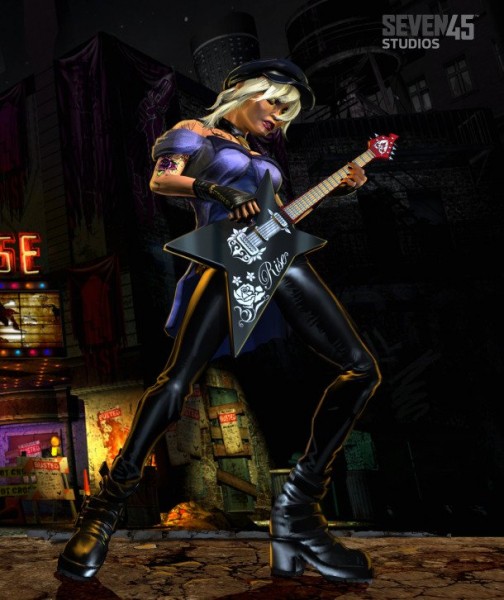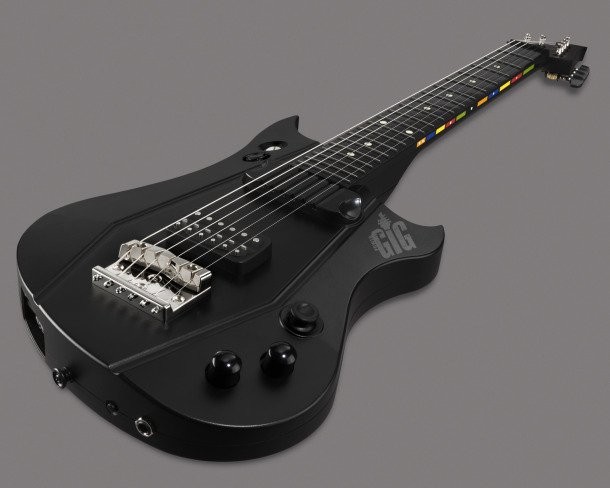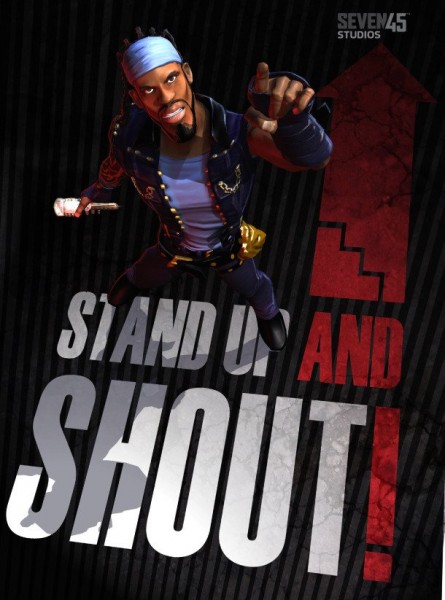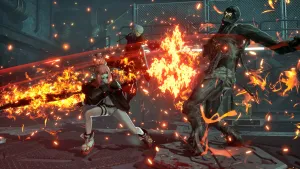Power Gig: Rise of the SixString

Today marks the announcement of the latest contender in the music genre; new publisher/developer Seven45 Studios introduces real instruments into the mix with Power Gig.
Seven45 Studios is not a name that will be familiar to gamers, but its sister organization may strike a chord. First Act has long been a player in the musical instrument business, providing many of the introductory guitars and other instruments that can be found at big box retailers like Walmart. The company has decided to parlay their success at large scale instrument sales into the video game music genre, announcing today the forthcoming release of Power Gig: Rise of the SixString.
We got a sneak peek at the game last week when the folks from Seven45 swung by our offices. They showed us their brand new guitar peripheral (which doubles as a real guitar) and also revealed a little bit of the game in action.
Power Gig follows in the footsteps of Rock Band and Guitar Hero, providing players with a full band experience through a mix of rock songs and beat matching gameplay. However, several features set Power Gig apart. Most notably, its instruments are designed to offer a more realistic sense of music creation. Meanwhile, the game’s story moves in the opposite direction, delivering a fictional adventure that promises to be more involved than the growth of your band from nobody losers into rock stars.
The most striking element of the game’s initial reveal is the SixString guitar peripheral. Slightly larger than most existing guitar peripherals, but still smaller than many actual guitars, the SixString doubles as a game controller and a playable guitar. Between the pick-ups and the base of the neck is an easy to toggle mute. Depress the string muter, and the guitar’s strings sound normally. When the mute is up, it gently muffles the strings, enabling use as a controller. The neck of the guitar reveals familiar color-coded frets. Beginning with the second fret, there’s a progression of colored bars: green, red, yellow, blue, orange, black, then a repeat of green, red, yellow, blue, and orange. When in real guitar mode, the SixString can be plugged into an amp and played like any other guitar. The sound produced isn’t necessarily the most high-quality we’ve ever heard, but it definitely works as promised.


Gameplay is split into two distinct modes: beat matching and chord play. The beat matching will be familiar to any music game fan – press down any string on the designated colored fret as that colored gem crosses the hit zone on screen. Chord play works similarly, but with an added challenge. In this mode, the colored gems onscreen can include a number, which indicates which exact string you should depress. In either game mode, there are five difficulty settings through which players will progress.
When tackling chord play on the highest difficulty, you begin to experience some of the same finger positions required to play the game for real, albeit without a clear sense of the required fingering or barring techniques that might be involved in doing so. Nonetheless, the game offers a bridge of sorts between gameplay and actual musicianship that has yet to be explored by other games.
We only got a short glimpse of the game in action, and the songs shown to us weren’t confirmed for final use in the game. However, the representatives from Seven45 Studios were quick to point out that they were aiming to match a number of songs on the disk with other music titles currently on the market, which would suggest between 50 and 90 tracks. Seven45 also has the cooperation and participation of all four major music labels, and plans to include only original master recordings in the final game.
In-song action appears very similar to existing music game software; each instrument has a set of descending gems that must be triggered in time with the music to succeed. There’s even a slowly building “mojo” meter that can be triggered in a similar way to Guitar Hero’s “star power”.
The SixString will be cross-compatible with all existing music games. In addition, Power Gig is playable using your existing Rock Band or Guitar Hero guitar, albeit in beat matching mode only.
Power Gig will launch with other instruments beyond the new SixString peripheral, including a new take on the drum set peripheral. These other new instruments aren’t yet ready for public viewing, but Seven45 promises some equally innovative features for any peripheral they release for the game.
When the game launches, gamers will be able to purchase a bundle that includes the game, a SixString guitar peripheral, guitar strap, picks, and extra guitar strings. Other bundles remain to be announced. As for price, Seven45 wasn’t yet ready to nail anything down, beyond saying that they hope to price their product “comparably” to existing music peripherals.
It’s far too early to have a clear sense of how Power Gig will really play. The two existing franchises on the market certainly offer some stiff competition against a newcomer. Still, it’s nice to see new ideas emerging in the music game genre; whether it’s Power Gig or an existing series, the music game industry will need to evolve to remain relevant in the coming years.
Does the possibility of a peripheral that turns into a real musical instrument hold any appeal to you?


Get the Game Informer Print Edition!
Explore your favorite games in premium print format, delivered to your door.
- 10 issues per year
- Only $4.80 per issue
- Full digital magazine archive access
- Since 1991










